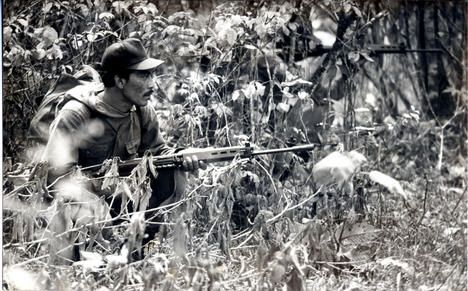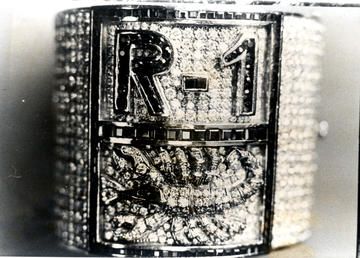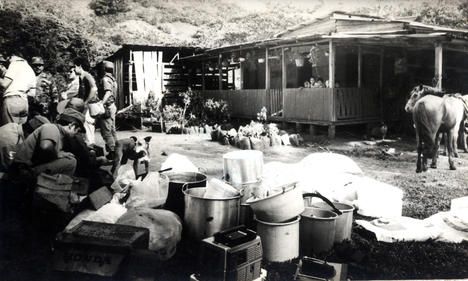
Publisher:
Bonnie King
CONTACT:
Newsroom@Salem-news.com
Advertising:
Adsales@Salem-news.com

~Truth~
~Justice~
~Peace~
TJP
Nov-01-2013 18:57

 TweetFollow @OregonNews
TweetFollow @OregonNews
Costa Rican Journalist Calls for Re-Examination of CIA-Contra Drug Links, DEA Agent's Murder
Salem-News.comLafitte Fernández claims that in the 1980s, the administration of U.S. President Ronald Reagan went into league with the largest drug traffickers of the era to ship copious quantities of cocaine through Costa Rica and El Salvador to the United States to help support the Contras.
 The Costa Rican mansion where drug kingpin Rafael Caro Quintero was arrested in 1985. Photos: Tico Times |
(SAN JOSE) - A crusading Costa Rican journalist working in El Salvador has challenged fellow reporters in Costa Rica to get to the bottom of the presence of Mexican drug kingpin Rafael Caro Quintero in Costa Rica in 1985.
Tico journalist Lafitte Fernández claims new evidence suggests Quintero was part of a wide-ranging conspiracy to arm and train Nicaraguan Contra rebels with the proceeds of cocaine trafficking through Central America.
Writing for the Salvadoran newspaper Diario 1, Fernández attempted to connect the dots of a number of seemingly scattered events to make the explosive charge that in the 1980s, the administration of U.S. President Ronald Reagan went into league with the largest drug traffickers of the era – Caro Quintero, Colombian drug lord Pablo Escobar, the Bolivian “King of Cocaine” Roberto Suárez and Honduran trafficker Juan Matta Ballesteros – to ship copious quantities of cocaine through Costa Rica and El Salvador to the United States to help support the Contras.
The alleged conspiracy even includes Nazi war criminal Klaus Barbie, who Fernández said colluded with Suárez in the cocaine-trafficking business in Bolivia.
“My purpose isn’t to rewrite history based on what has been written. It’s to use this as a point of departure to find the truth that we should have found years ago,” Fernández told The Tico Times.
According to Fernández, ground zero for the cocaine and arms trafficking was El Salvador’s Ilopango Air Base, where both the U.S. Central Intelligence Agency and “private benefactors” – who helped the Contras when the U.S. Congress had prohibited official aid – maintained airplane hangars through which arms flowed to the Contras and cocaine to U.S. markets.
Fernández draws on information from a number of sources, including the book “Powder Burns” by former U.S. Drug Enforcement Administration (DEA) official Celestino Castillo, who detailed the running of cocaine through Ilopango.
Castillo said airplanes that flew weapons to Contra rebels through Ilopango would return with cocaine that was then transshipped to U.S. military bases, where it did not have to go through U.S. Customs.
According to his book, when Castillo tried to bring up the matter with his superiors, he was told to drop it.
 The Contra's Southern Front, April 22, 1983. Mario Castillo/La República/Tico Times |
Fernández alleges that the flights were made possible by a deal U.S. National Security Council official Lt. Col. Oliver North struck with Panamanian Dictator Manuel Antonio Noriega and the traffickers, which guaranteed the drug lords access to the U.S. market in exchange for support for the Contras.
The Iran-Contra record shows that North had a least one personal meeting with Noriega on Sept. 22, 1986, while Noriega was under close scrutiny for drug trafficking.
Fernández cites the book “The King of Cocaine,” by Suárez’s widow, Ayda Levy, which recounts a deal struck between North, Suárez, Escobar and Noriega so that the first three received 30 percent of the profits with 10 percent going to Noriega.
According to the book, quoted by Fernández, on the return trip to South America, Suárez told Escobar, “Pelican, from today we’re playing in the big leagues, but we have to proceed with much care. Those Gringos are more dangerous than a monkey with a razor.”
Noriega was overthrown in the 1989 U.S. invasion of Panama and subsequently served prison time in the U.S. and France before returning to Panama, where he currently resides. Escobar was killed by Colombian forces in December 1993, and after serving eight years in prison in Bolivia, Suárez was released in 1996 and died of natural causes in July 2000.
Citing “The King of Cocaine,” Fernández writes that Noriega arranged a meeting in 1982 between Suárez and Escobar and then-Costa Rican presidential candidate Luis Alberto Monge, in which the drug lords allegedly gave Monge $2 million to fund his campaign in exchange for free rein to ship cocaine through Costa Rica’s Puerto Limón, on the Atlantic coast, and an airstrip in the northwestern province of Guanacaste, where it was transshipped to Ilopango Air Base or directly to the United States.
Monge has vehemently denied the charges, saying he can prove that he was campaigning in Costa Rica at the time the alleged Panama meeting with the drug barons took place.
In April 1985, while Monge was president, Caro Quintero fled to Costa Rica following the murder in Mexico of DEA agent Enrique Camarena, who endured 30 hours of torture before being killed, allegedly for having busted a large marijuana plantation belonging to Caro Quintero.
In an early morning raid, Costa Rican police accompanied by DEA agents burst into the Finca California in the Ojo de Agua sector of Alajuela near Juan Santamaría International Airport, north of the capital, surprising Caro Quintero and a number of his confederates.
According to press reports, Caro Quintero, who also allegedly provided space on his Mexican ranch to the Contras for training, complained to his captors that he had paid handsomely to find haven in Costa Rica.
A Costa Rican Legislative Assembly commission that investigated the affair concluded that a “high political authority” was responsible for the drug lord’s arrival to Costa Rica, but did not name a name.
Another legislative commission assigned to investigate revelations made by a U.S. congressional commission that probed Contra drug trafficking recommended that several former U.S. officials, including North and former U.S. Ambassador Lewis Tambs, be banned from entering Costa Rica for their role in facilitating drug trafficking.
 A ring worn by drug kingpin Rafael Caro Quintero. |
“This country installed two investigative commissions on matters of drug trafficking. My question is whether their members deceived us or whether they also were deceived,” Fernández said. “Look what has happened with Caro Quintero. Now it turns out that he did not kill Camarena, but that they sent someone to kill him from El Salvador.”
The Mexican news magazine Proceso two weeks ago made the startling accusation that the CIA was involved in the murder of Camarena to silence the drug agent after he stumbled on the Contra drug operation.
In the article, which cited two former DEA agents and a CIA contract pilot, the magazine claimed that the famed CIA operative Félix Rodríguez, a Cuban Bay of Pigs veteran, not Caro Quintero, was behind Camarena’s murder.
A Fox News report on the same subject using the same sources did not go so far as to accuse U.S. officials of ordering Camarena’s murder, but did place U.S. intelligence assets at the scene of Camarena’s interrogation and killing. Fox said that the sources had identified “a Cuban” as one of the “assets” at the scene, but did not identify Rodríguez.
Rodríguez, who resides in Miami, denied the Proceso allegations and threatened to sue the sources of the information for slander. Rodríguez, who was in on the 1967 capture and execution of the Argentine revolutionary Ernesto “Ché” Guevara, attributed the story to the machinations of Cuban intelligence to coincide with the Oct. 9 anniversary of Guevara’s death. He has also denied any knowledge of cocaine traffic through Ilopango Air Base, even though he, along with fellow Cuban CIA operative Luis Posada Carriles, allegedly oversaw the Contra arms operation through the base.
Though the stunning allegations of CIA involvement in Camarena’s murder have been aired only by Fox in the United States, the charges have found widespread dissemination in Mexico and Central America, where numerous news outlets picked up the story, and in Spain, where one of that country’s principal newspapers, El País, picked it up.
If true, the allegations throw the arrival of Caro Quintero to Costa Rica in an entirely different light, Fernández said.
“I am convinced that they are hiding things here. There’s no will in the media, where I have many close and respected friends, to assume the challenge of putting the facts in their place. Ask yourself why?” he said.
In an op-ed piece following his four-part series, Fernández challenged Tico journalists to get to the bottom of the affair.
“My Costa Rican colleagues, have courage, don’t remain silent. Demand explanations. They deceived my generation. I hope that my generation can also write the truth, helped by young journalists,” Fernández wrote.
The editor-in-chief of Semanario Universidad, Mauricio Herrera, said he would be interested in pursuing the story.
“If we can have firsthand access to those testimonies and evidence, we would dare to publish something,” Herrera said.
 One of several Contra camps in Nicaragua in the 1980s. Tico Times |
The apparent lack of press interest in the U.S. could be a reflection of how poisonous the entire Contra drug story became for journalists after Gary Webb, a reporter for the San Jose, California-based Mercury News, committed suicide in 2004 following his editors’ repudiation of a series he wrote linking Contra drug-running to the rise of the crack cocaine epidemic in Los Angeles and then the U.S. as a whole.
Initially supportive, Mercury News editors backed away from the story after The New York Times, The Los Angeles Times and The Washington Post wrote articles claiming that the amount of drugs run by the Contras was not enough to have sparked the crack epidemic that devastated inner-city communities, especially the black community, throughout the U.S.
Webb was demoted to a suburban San Jose bureau from his job covering California’s capital of Sacramento, and he eventually quit, finding work first as a legislative aide and then working for alternative media.
Unable to find a job on a major daily, Webb apparently fired two bullets into his head on Dec. 10, 2004. Despite the unusual manner of his death, the Sacramento coroner’s office ruled it a suicide. Some, including Lafitte Fernández, have not accepted the coroner’s findings and continue to believe that Webb was murdered.
In the aftermath of Webb’s series, and the accompanying outcry in the black community, the CIA’s Inspector General Fredrick Hitz conducted an investigation that found no evidence agency personnel were involved in drug trafficking, but did detail that a number of individuals within the Contra movement and others who assisted the Contras did traffic in drugs.
Amid the articles critical of Webb’s reporting, the Washington Post Ombudsman noted that the three newspapers devoted more attention to reporting on what did not happen than on illuminating exactly what did happen.
Perhaps as a result, after nearly 30 years, at least in Latin America, the Contra drug tale still has legs.
An earlier version of this story incorrectly stated that Lt. Col. Oliver North worked for the U.S. National Security Agency. He worked for the U.S. National Security Council. We regret the error.
 |
 |
 |
Articles for October 31, 2013 | Articles for November 1, 2013 | Articles for November 2, 2013
Quick Links
DINING
Willamette UniversityGoudy Commons Cafe
Dine on the Queen
Willamette Queen Sternwheeler
MUST SEE SALEM
Oregon Capitol ToursCapitol History Gateway
Willamette River Ride
Willamette Queen Sternwheeler
Historic Home Tours:
Deepwood Museum
The Bush House
Gaiety Hollow Garden
AUCTIONS - APPRAISALS
Auction Masters & AppraisalsCONSTRUCTION SERVICES
Roofing and ContractingSheridan, Ore.
ONLINE SHOPPING
Special Occasion DressesAdvertise with Salem-News
Contact:AdSales@Salem-News.com





Terms of Service | Privacy Policy
All comments and messages are approved by people and self promotional links or unacceptable comments are denied.
[Return to Top]
©2025 Salem-News.com. All opinions expressed in this article are those of the author and do not necessarily reflect those of Salem-News.com.